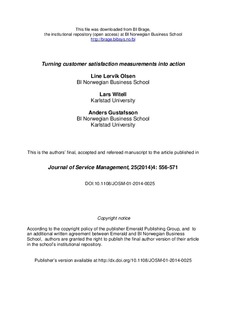Turning customer satisfaction measurements into action
Journal article, Peer reviewed
Permanent lenke
http://hdl.handle.net/11250/223194Utgivelsesdato
2014Metadata
Vis full innførselSamlinger
- Publikasjoner fra CRIStin - BI [1015]
- Scientific articles [2181]
Originalversjon
Journal of Service Management, 25(2014)4: 556-571 http://dx.doi.org/10.1108/JOSM-01-2014-0025Sammendrag
Purpose – The purpose of this paper is to contribute to the literature on customer orientation by
developing and empirically testing a model that attempts to explain the elements that constitute
customer orientation and that, in turn, influence customer satisfaction. In particular, this study focuses
on how service firms design, collect, analyse and use customer-satisfaction data to improve service
performance. This study has the following three research objectives: to understand the process and,
as a consequence, the phases of customer orientation; to investigate the relationships between the
different phases of customer orientation and customer satisfaction; and to examine activities in the
different phases of customer orientation that result in higher customer satisfaction.
Design/methodology/approach – This study, combining quantitative and qualitative research, is
based on a cross-sectional survey of 320 service firms and a multiple case study of 20 organisational
units at a large service firm in the European telecom industry.
Findings – The results show that customer orientation consists of a process that includes three
phases: strategy, measurement and analysis and implementation. Contrary to previous research,
implementation has the strongest influence on customer satisfaction. In turn, customer satisfaction
influences financial results. In-depth interviews with managers provided insights into the specific
activities that are key for turning customer-satisfaction measurements into action.
Originality/value – This research contributes to the literature on customer orientation by developing
and empirically testing a model that attempts to explain what constitutes customer orientation and, in
turn, influences customer satisfaction and financial results. Given the large amount of research on
customer satisfaction, studies on how service firms collect and use customer-satisfaction data in
practice are scarce.
Beskrivelse
This is the authors’ final, accepted and refereed manuscript to the article. Publisher’s version available at http://dx.doi.org/10.1108/JOSM-01-2014-0025
